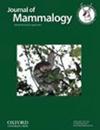Noninvasive EEG measurement of sleep in the family cat and comparison with the dog
IF 1.6
3区 生物学
Q2 ZOOLOGY
引用次数: 0
Abstract
We have successfully measured the sleep electroencephalogram (EEG) of 12 family cats during an afternoon nap using a completely noninvasive methodology originally developed and validated for family dogs. Extracting both macrostructural and spectral sleep variables from the acquired data, we: (1) provided a descriptive analysis of sleep structure in cats and the power spectral density (PSD) distribution considering 3 sleep stages—drowsiness, non-rapid eye movement (NREM), and rapid eye movement (REM) sleep; and (2) compared the results to those obtained in family dogs measured under the same conditions and using the same methodology. Importantly, our description of sleep structure and PSD distribution in cats proved to be comparable to those of earlier invasive studies, highlighting that appropriate noninvasive methodologies may provide a viable alternative to those that are invasive in some cases. While no macrostructural differences were found between the sleep of cats and dogs, and the characteristic PSDs were mostly similar across sleep stages within the 2 species, the high-frequency resolution comparison of PSD distributions revealed differences between the 2 species in all sleep stages (concerning the delta, theta, alpha, sigma, and beta bands in drowsiness and NREM sleep; and the delta, alpha, and sigma bands in REM sleep). Potential factors underlying these differences are discussed, including differences in circadian rhythms, sleep homeostatic regulation, experienced stress, or even differential attitudes toward owners—highlighting important links between sleep characteristics and often more complex neural and behavioral features.对家猫睡眠的无创脑电图测量以及与狗的比较
我们采用一种最初为家犬开发和验证的完全无创方法,成功测量了 12 只家猫午睡时的睡眠脑电图(EEG)。我们从获取的数据中提取了宏观结构和频谱睡眠变量:(1) 对猫的睡眠结构和功率谱密度 (PSD) 分布进行了描述性分析,并考虑了三个睡眠阶段--嗜睡、非快速眼动睡眠 (NREM) 和快速眼动睡眠 (REM);(2) 将结果与在相同条件下使用相同方法测量的家犬的结果进行了比较。重要的是,我们对猫的睡眠结构和 PSD 分布的描述与早期的侵入性研究结果相当,这表明在某些情况下,适当的非侵入性方法可以替代侵入性方法。虽然在猫和狗的睡眠中没有发现宏观结构上的差异,而且这两种动物在不同睡眠阶段的 PSD 特征也基本相似,但 PSD 分布的高频分辨率比较显示,这两种动物在所有睡眠阶段都存在差异(嗜睡和 NREM 睡眠中的 delta、theta、alpha、sigma 和 beta 波段;REM 睡眠中的 delta、alpha 和 sigma 波段)。本文讨论了造成这些差异的潜在因素,包括昼夜节律、睡眠平衡调节、经历的压力、甚至对主人的不同态度等方面的差异--这凸显了睡眠特征与通常更为复杂的神经和行为特征之间的重要联系。
本文章由计算机程序翻译,如有差异,请以英文原文为准。
求助全文
约1分钟内获得全文
求助全文
来源期刊

Journal of Mammalogy
生物-动物学
CiteScore
3.30
自引率
5.90%
发文量
106
审稿时长
4-8 weeks
期刊介绍:
Papers are published on mammalian behavior, conservation, ecology, genetics, morphology, physiology, and taxonomy.
 求助内容:
求助内容: 应助结果提醒方式:
应助结果提醒方式:


